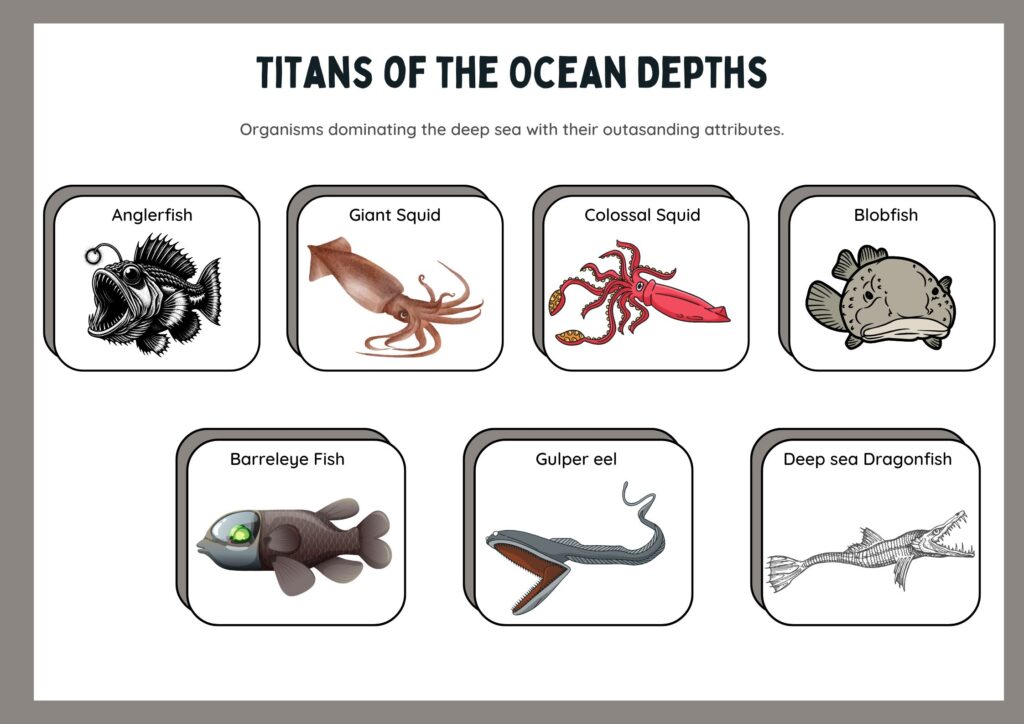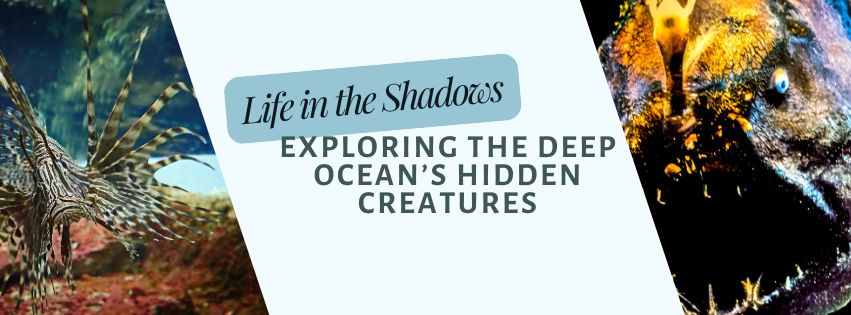The deep ocean is a mysterious and largely undiscovered world, covering more than 80% of our planet’s oceans. This dark world is occupied by multiple fascinating deep ocean creatures. This world and its residents remains unexplored due to its depth, harsh conditions and lack of sunlight.
Photosynthesis occurs only up to 100–200 meters deep, where sunlight still reaches. As we go deeper, light gradually disappears. Beyond 1000 meters, the ocean becomes completely dark. The Mariana Trench, at 11,000 meters, is the deepest part of the ocean floor. It remains in total darkness and extreme cold, making survival incredibly difficult.
Do explore about ocean floor read –
https://www.noaa.gov/education/resource-collections/ocean-coasts/ocean-floor-features
https://youtu.be/sE8JYv_cKng?si=RNHpf1u5mG6Jh_y4 understand more about deep ocean
Despite extreme conditions like freezing temperatures, crushing pressure, and never ending darkness, these deep ocean creatures occupy this territory. These hidden creatures display remarkable resilience and adaptability. They survive using traits like bioluminescence, slow metabolism, gelatinous and flexible bodies, camouflage, and more. Exploring this hidden world reveals its incredible biodiversity. It also highlights the deep ocean’s vital role in Earth’s ecosystem and climate regulation.
In this blog we’ll uncover some of their unique features that not only supports these deep ocean creatures persist but help them flourish in remarkable ways.
Deep Ocean Creatures and Their Secrets to Survival
The deep ocean life is one of the most inhospitable environments on earth. Its extreme circumstances burdens these deep ocean creatures to dwell thus they exhibit extraordinary trait to cope with such conditions. Some of their challenges and their features to defend it are list below :
1. Acclimatizing to Darkness –
The deep ocean is filled with darkness due to lack of sunlight, thus its difficult for organisms to navigate, hunt and even avoid predators. They bear features like –
i) Bioluminescence – produce their own light through chemosynthesis, that assist them by attracting prey, facilitate communication, help in camouflaging and even scare off predators.
ii) Enhanced Vision – large eyes captures faintest traces of light including bioluminescence , upward facing eyes or transparent heads to detect shape of preys above.
2. Pressure Resistance –
As the oceans gets deepen the atmospheric pressures increases which can be 1000 times higher in deepest trench than of surface. These creatures have evolved with peculiar traits like –
i) Flexible, Gelatinous Bodies – instead of rigid skeletal structures they have soft, bendable bodies protecting them fro getting crushed due to pressure.
ii) Unique Cell membrane – cells of these organisms contains pressure resistant proteins and lipids that protects cellular damage.
3. Enduring Freezing Temperatures –
Temperatures in deep ocean ranges from 0oC to 3oC that’s nearly freezing, thus creatures adapt to the the cold through –
i) Slow Metabolism – lower metabolism conserves energy that means they can survive with limited food.
ii) Modification in Enzymes – commonly enzymes don’t function at lower temperatures but these organisms produce enzyme that even function in cold conditions.
iii) Freeze inhibitor proteins – some organisms synthesize antifreeze proteins which prevent crystal formation in their bodies.
4. Camouflage and Defense Mechanisms –
Lack of light makes both predator and prey to be deceptive and covert to survive this challenging situation to get food and protect themselves. Thus they need some physical adaptation to blend well in the surrounding, which includes –
i) Transparency – imagine an organism is invisible in its habitat, it will be difficult to locate them may it be a predator or prey. Thus some deep ocean creatures are transparent – eg Glass squid.
ii) Dark or Red Pigmentation – red light doesn’t penetrate very far underwater, so many deep-sea creatures appear black or red as they blend into the darkness.
iii) Spines and Hooks – physical defenses like sharp spines help prey to keep predator away.
5. Gigantism and Miniaturization –
The size variation seen in deep sea creatures exhibit a distinctive characteristic that supports them coping with extreme conditions and its a outcome of their metabolic activity.
i) Gigantism(Massive body) – Some organisms like giant squid or Japanese spider crab grows enormously in size as a result of slow metabolism which extends their lifespan resulting in large body sizes. Their mighty appearance scare off predators, increase their mobility, store energy as well as handle extreme pressure.
ii) Miniaturization(Tiny body) – Organisms those are exceptionally small can survive in environment with sparse resources by using minimal energy and food to sustain. These miniature creature adapt by keeping their metabolism low which lowers food requirement. Their scale down body lend them hand through protection from predation, quick reproduction by spreading their population further increasing their population despite of harsh conditions.
As we went through these remarkable qualities extending kingdom of these organism deep below, let’s now comprehend about some of the organisms which are dominating the habitat with their outstanding attributes.
Titans of the Deep : Meet the Ocean’s Mightiest Creatures
1. Anglerfish –
Unique Traits –
– Bioluminescent lure above its head to attract prey in complete darkness
– Extendable jaw and stomach that allows consume even double sized prey and store it when food is in abundance
– Males are significantly smaller and attach themselves on females like parasite for reproduction.
2. Giant Squid –
Unique Traits –
– Enormous in size, one of the largest invertebrates on earth, thus easily sustain extensive pressure in deep ocean thus are rarely seen alive.
– Bear huge eyes up to 30cm in diameter which helps them detects faint light and silhouettes in deep ocean.
3. Colossal Squid –
Unique Traits –
– They have rotating hooks on its tentacles helps capture and hold onto large prey
– it’s larger and bulkier than the giant squid hence both inhabits in same conditions.

4. Blobfish –
Unique Traits –
– Gelatinous body with no swim bladder that prevents them from crushing caused by high pressure.
– They have gelatinous mass with density lower than water prevents them hitting ocean floor maintaining buoyancy without using energy.
5. Barreleye Fish –
Unique Traits –
– Transparent head that allows them see through it and easily locate prey above them.
– They are named as their eyes are tubular-barrel shaped which facilitates detection of silhouettes above head and can rotate to look forward when needed.
6. Gulper Eel – also known as pelican eel
Unique Traits –
– They have oversized mouth and expandable stomach which helps them gulp prey twice their size and store food when food is in abundance
– They have vey long, whip-like tail assumed to emit bioluminescent light to attract prey in dark.
* Note – Describing Gulper eel is quite difficult as scientist study them through old specimen as they are so frail outside the deep sea’s pressure that their body gets quickly damaged.*
7. Deep sea Dragonfish –
Unique Traits –
– They are apex predators with fang like teeth in jaws which can open more than 100 degrees thus aids gulping large preys.
– They have bioluminescent barbel that lures prey and scare off predators.
– Their teeth are transparent making them nearly invisible in dark which help in hunting down prey.
These organisms live deep in the oceans, yet some bioluminescent species also appear near the sea surface.
Such organism is jellyfish, which have found to suddenly risen during recent years due to some human activities. Read more about them –
Revealing the Unknown : What Deep Ocean Creatures Can Teach Us
As of today the deep oceans still largely remains unexplored and its said that about 80% of the ocean floor is yet to be observed, studied and mapped. Its extremely harsh conditions, immense size, technological and financial limitations is hindering the research and analysis. Despite these constrains and modern tools like Remotely Operated Vehicles(ROVs), Autonomous Underwater Vehicles(AUVs), Underwater cameras, echo sounders, sonar systems and many more are continuously investigating to get maximum information possible.
Many scientists suggest that there are still some mysteries to be unmasked in this un-illuminated natural world. They particularly advocate things like Gigantic invertebrates, bioluminescent organism, microfauna and extreme thermophiles if studied can open door to evolutionary sciences as well lead to some discoveries in biology and medicine. Its assumed that a deposit of rare earth elements could exist on this unmapped seafloor. Organisms living in extreme environment behold some genetic secrets that benefits in survival, their genetic analysis can be a break through in biotechnology and medicines.
In the Depths of Darkness, Discovery Awaits
The deep ocean world filled with astonishing biodiversity, impenetrable darkness, crushing depths still remains one of the Earth’s mysterious stretches. Through discovering any of its hidden gem we unlock the gateway of some unmatched phenomenon of this inhumane habitat. As our technology advances it equips our analysis to unveil the deepest mysteries which are concealed in the gloomy environment.
So, the next time you look out over the ocean, remember that beneath the surface lies a world of wonders waiting to be explored.

Leave a Reply